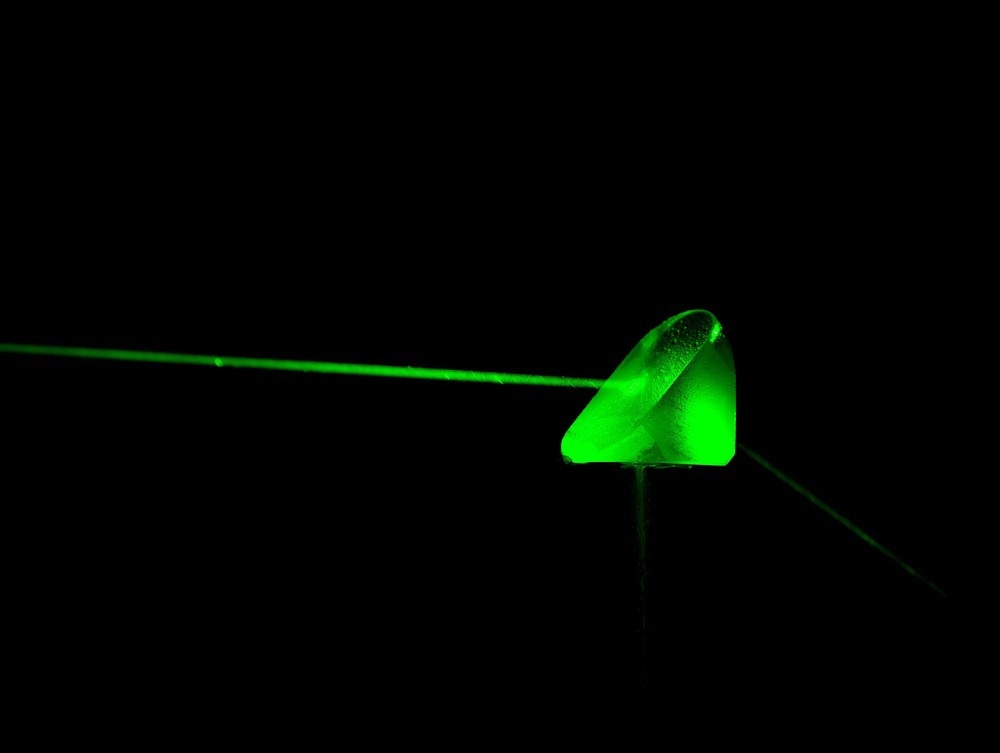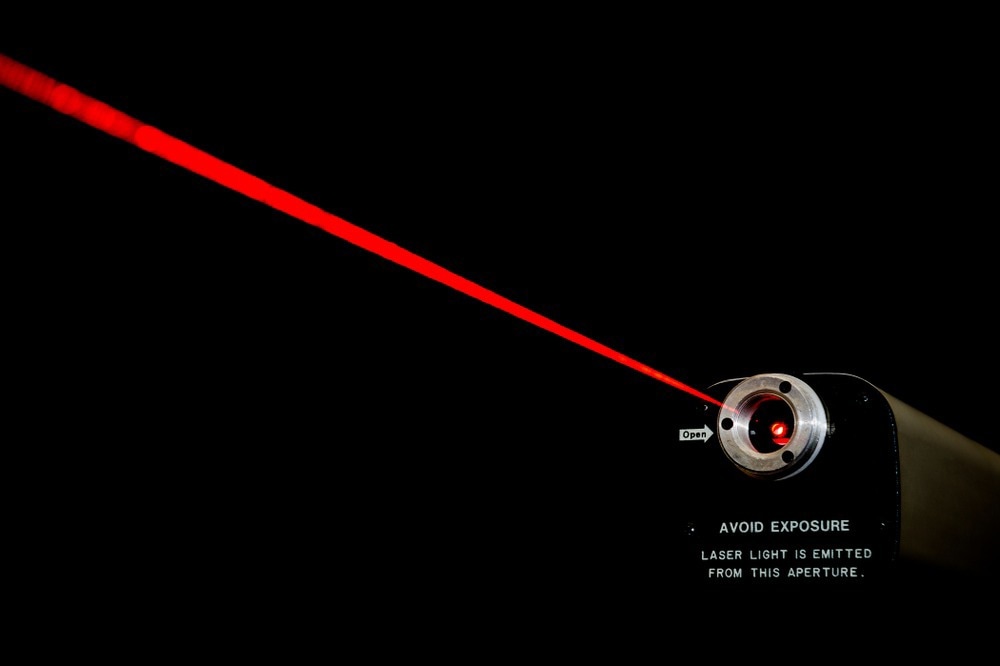The characteristic properties of a laser beam can be modified by beam-shaping techniques to meet the demands of specific applications. In order to achieve a desirable beam profile that is maintained over the intended propagation distance, beam shapers redistribute the irradiance of an optical beam with appropriate adjustments of its phase.

Image Credit: Doug McLean/Shutterstock.com
The irradiance distribution and phase of a laser beam are often used to describe its form. The latter is crucial for assessing a beam profile's homogeneity along its propagation distance. Typical irradiance distributions include the Gaussian, which shows a decline in irradiance with increasing radial distance, and the flat-top beams, which show a constant irradiance across a certain region.
Different beam profiles other than the conventional Gaussian profile of a laser are sometimes advantageous for specific applications. For instance, flat top profiles are preferable to Gaussian beams in applications like materials processing systems because the flat top profile provides more precise and predictable cuts and edges.
However, adding beam-shaping optics makes the complete optical system more complicated and expensive.
Theoretical Limitations of Beam Shaping
Beam shaping affects the basic characteristics of light. The Heisenberg uncertainty principle related to position and momentum governs how effective it is.
The design of beam shapers is constrained by the uncertainty principle. For instance, the spatial frequencies become less defined for a design with a highly well-defined location. A characteristic parameter is determined by applying the uncertainty principle to diffraction theory, specifically the Fresnel integral of the Fourier transform relation.

where z is the distance from the output plane, λ is the wavelength, C is a constant, and Ri and Ro are the input and output beam half-widths, respectively. When developing a beam shaping application, the value of β is crucial since higher values are correlated with greater beam shaping performance. This formula also suggests that designing beam shapers for bigger beams, shorter wavelengths, and closer focus distances will be simpler.
Gaussian beams may be physically trimmed by an aperture to generate a pseudo-flat top profile in low-performance systems when cost is a deciding issue. Although this is ineffective and wastes energy on the Gaussian profile's periphery, it reduces system complexity and expense.
Several beam-shaping techniques that are actively employed are summarized below.
Refractive Beam Shaping
Laser beam shapers that are either diffractive or refractive are frequently used in higher-performance applications that need more efficiency.
The irradiance and phase profile of laser light is often redistributed in refractive beam-shaping assemblies. Diffractive optical elements and aspheric or freeform lenses, which are field-mapping phase elements, are primarily used in such assemblies. A refractive field mapper uses wavefront distortion and the energy conservation constraint to convert the Gaussian beam profile into a flat top profile. In a Keplerian or Galilean lens assembly, the incident beam's amplitude and phase are altered after passing through both components. Within the boundaries of the design, the resultant beam shaping is extremely effective and wavelength agnostic. Flat phase fronts and homogeneous irradiance distribution are made possible by refractive beam shapers.
Diffractive Beam Shaping
Diffractive beam shapers modify the laser beam into a certain irradiance distribution by using diffraction rather than refraction. Etching is a technique used by diffractive elements to produce a specific nanostructure in a substrate. Usually, the height and zone spacing have an impact on the element's function and design wavelengths. Therefore, it is crucial to use a diffractive optical component at the design wavelength to prevent performance issues. Diffractive elements are also more reliant on alignment, divergence, and the beam location in the plane to refractive beam shapers. However, since diffractive optical components often consist of a single element rather than a number of refractive lenses, they are far more favorable in laser systems with limited space.

Image Credit: Doug McLean/Shutterstock.com
Laser Beam Integrators
A lens or other focusing device is used to superimpose the beamlets at the target plane in a laser beam integrator, also known as a homogenizer. Multiple Ienslets are used to split the beam into an array of smaller beams, called beamlets. Both coherent laser beams and other light sources can be input into a laser beam integrator. The total of the diffraction patterns generated by the lenslet array typically represents the final output beam profile. A homogenized flat top profile is produced by most laser beam integrators using incident Gaussian beams.
Circularizing Beams with Cylinder Lenses
Circularizing a beam is a new kind of laser beam shaping that entails changing an oval or other non-circular profile to a circular one. Cylinder lenses employ curved surfaces to converge or diverge light, much like conventional spherical lenses do; however, they only have optical power in one direction. The perpendicular dimension of light is unaffected by cylindrical lenses. Standard spherical lenses are unable to do this because they force light to equally concentrate or diverge in a rotationally symmetric way. Because of this quality, cylinder lenses are effective in circularizing elliptical beams and forming laser light sheets.
Circularizing Beams with Prism Pairs
Other forms of optics for circularizing elliptical beams include pairs of anamorphic prisms. Two prisms are combined to distort a laser beam in anamorphic prism pairs. They can create additional elliptical beam profiles in a range of sizes, although they are primarily employed to convert elliptical beam profiles into circular distributions. The reshaping is accomplished using the same optical technique as cylinder lenses: refraction. While one axis, or direction, of light is twisted, the other axis stays unchanged. This accounts for the various divergence angles of the beam.
Outlook
Apart from the beam shaping techniques described above, various other methods are also broadly employed, dependent on the demands of particular applications. Most methods excel at eliminating spherical aberration and reducing other optical aberrations while increasing throughput. A thorough overview of the practicalities of beam shaping in many areas for prospective applications, supported by significant efforts to uncover the real nature of structured light and its characteristics, is provided in a number of literary publications.
More from AZoOptics - Laser Safety: Guidelines and Best Practices for Laser Users and Operators
References and Further Reading
Fred M. Dickey, Louis S. Weichman, Richard N. Shagam, "Laser beam shaping techniques," Proc. SPIE 4065, High-Power Laser Ablation III, (16 August 2000); https://doi.org/10.1117/12.407361
Edmund Optics. . Laser Beam Shaping Overview. [Online] Edmundoptics.com. Available at: https://www.edmundoptics.com/knowledge-center/application-notes/optics/laser-beam-shaping-overview/
Disclaimer: The views expressed here are those of the author expressed in their private capacity and do not necessarily represent the views of AZoM.com Limited T/A AZoNetwork the owner and operator of this website. This disclaimer forms part of the Terms and conditions of use of this website.